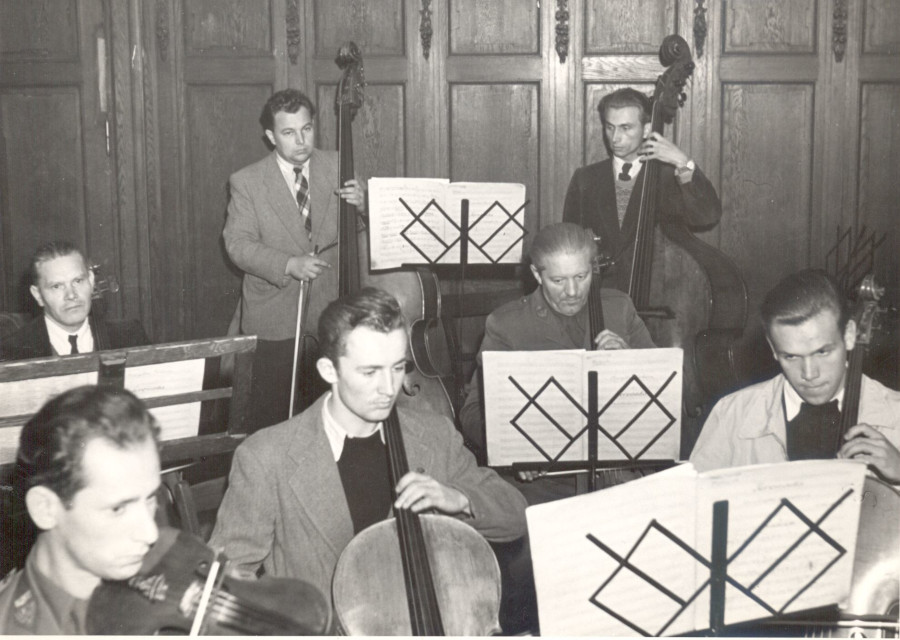When the Wrocław Symphony Orchestra began its regular activity in 1954, it had six positions. And the prospect of a hungry future.
The government did need music, but it was drenched in ideological sauce. Fortunately, the first conductor was Adam Kopyciński, an outstanding pianist who survived Auschwitz. The difficulties did not scare him. Wrocław waited five years for this orchestra. There were enough music lovers to break through with demands to the press, but in the Stalinist era, broadcasting in workplaces and programmes titled “With Melody to Plan” were more important.
The equipment reached the water meter factory on the birthday of the Generalissimo. A brigade of installers therefore made a commitment to put the factory radio into operation within three days. From then on, the working day in water meters began with a brisk march from sixteen loudspeakers. Then the news of political events and work competition were broadcast. On the socialist front, radio stations fought against lazy people, absent-minded people and bikiniarze. Pafawag workers listened, for example, to the programme “Our Blunderers” or “We Cut Out Botchers”. There was a lively polka in the hall, and then the text: “They sharpen scythes in the radio station, the lazybones have hidden their noses. The weeds are flying with a loud crack, asking for grace in vain”. In this situation, the request to create an orchestra was also motivated ideologically and on 27 December 1953, a memorial “On the Establishment of a Professional Lower Silesian Workers’ Philharmonic to celebrate the 2nd Congress of the PZPR [Polish United Socialist Party – translator’s note]” was sent to the Presidium of the National Council of the City of Wrocław. It was signed by second lieutenant Antoni Stanisławczyk (head of the Song and Dance Ensemble of the Military District), conductor Radomir Reszke and Wojciech Dzieduszycki as a representative of the Frederic Chopin Society. They offered concerts not only in the auditorium of the University of Technology, the Opera, the “Śląsk” Cinema (today Capitol), but also in factory halls for workers, in community clubs and community centres. It was difficult to refuse the commitment made on the occasion of the Congress of the Guiding Power of the Nation, the more so as the memorial announced that the orchestra had already started rehearsals. The word became flesh.
General and Artistic Director of WSO was the Rector of the State Higher School of Music (PWSM) Józef Lasocki, the Principal Conductor was Adam Kopyciński, and Radomir Reszke served as Associate Conductor. The struggle to get money for full-time jobs and to buy instruments began. The late Wrocław journalist Władysław Biełowicz recalled how the orchestra’s management strove to get to the Presidium of the Provincial Council asking for help, because there were not enough musicians. The sovereignty replied jokingly: “And you, dear ones, blow harder, and it will come out louder, without jobs! That’s it …”.
Fortunately, we managed to complete the orchestra and persuade the authorities to assume the role of a patron – two years later, the orchestra increased its employment to forty-eight positions. The first concert took place on 21 October 1954, conducted by Adam Kopyciński, and the star was Halina Czerny-Stefańska. The programme included works by Chopin, Liszt and Karłowicz. Władysław Zagórski published an enthusiastic review in Słowo Polskie: “We did not expect the ensemble to achieve such good sound and performance discipline after such a short period of rehearsals. As soon as the first notes of Karłowicz’s Serenade for String Orchestra sounded, we realized that we had to do with a real symphony orchestra.”
Zagórski complimented the conductor, stating that Liszt’s Preludes under his baton “had a wide breath and a lot of tension in the truly Romantic masterpiece”, and he fell to his knees in front of Czerny-Stefańska. There were encores and the orchestra could not leave the stage. For those who did not get to the concert (tickets were sold out within a few hours), two additional concerts were promised.
During four seasons, the orchestra gave a total of 248 concerts to over 100,000 listeners, and on 1 August 1958, the ensemble was named the State Philharmonic in Wrocław. Adam Kopyciński took over the management, artistic direction and the function of principal conductor.
Beata Maciejewska

